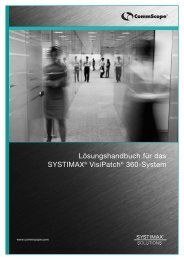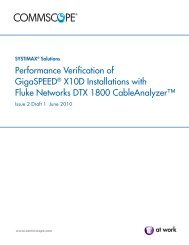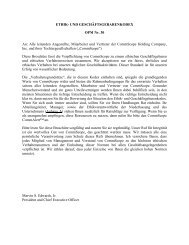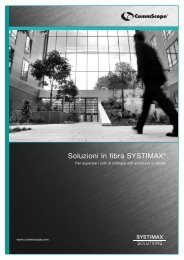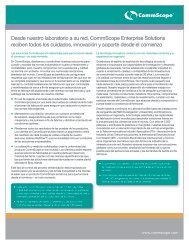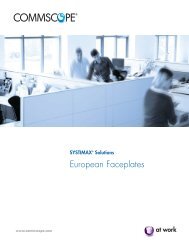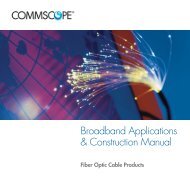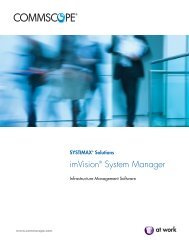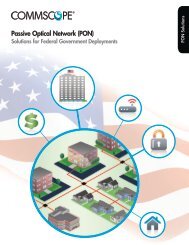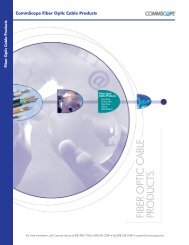CommScope® Enterprise Data Center Design Guide - Public ...
CommScope® Enterprise Data Center Design Guide - Public ...
CommScope® Enterprise Data Center Design Guide - Public ...
You also want an ePaper? Increase the reach of your titles
YUMPU automatically turns print PDFs into web optimized ePapers that Google loves.
48<br />
Interlocking Armored Cable<br />
Loose Tube Cable<br />
Tight Buffered<br />
www.commscope.com<br />
Trunk Cables<br />
Trunk cables are a subset of distribution cables that run in the data center between the Entrance<br />
Facility, MDA, HDA and EDA. Commonly trunk cables are factory-terminated with MPO or LC<br />
connectors. Although trunk cables could contain tight-buffered or ribbon fibers, today the best<br />
option is to use loose-tube fibers. Loose tube fibers typically have the lowest attenuation because<br />
they are not encumbered by an over-coating (900 μm) or stressed due to their attachment to the<br />
other fibers within a ribbon. Loose tube cable designs also provide the lowest density for the<br />
fiber counts most commonly seen in today’s data centers runs (12 – 144 fibers).<br />
Interlocking armored cables<br />
Distribution cables can be overlaid with interlocking aluminum armor that provides protection<br />
against damage due to extreme conditions. This eliminates the need for installing conventional<br />
conduit or innerduct, thus reducing the overall time and cost of the installation. Interlocking<br />
armor offers superior protection combined with excellent installation flexibility.<br />
Interlocking armored cables are NEC & CEC compliant for OFCR, OFCP and OFCR-LS<br />
(Low Smoke) applications.<br />
Indoor/Outdoor Fiber Optic Cables<br />
Indoor/outdoor cables may be plenum or riser-rated yet are tough enough for use outside.<br />
A water- blocking technology swells on contact with water to arrest moisture ingress and<br />
eliminate the need for a gel outside of the buffer tube. In loose tube cables, water-blocking<br />
technologies (either gel or gel-free) may be inside of the tube as further protection against<br />
moisture ingress.<br />
Distribution (tight buffer)<br />
Indoor/outdoor distribution cables are based on 12-fiber subunits, supported with a central<br />
dielectric strength member and protected with strength yarns impregnated with water blocking<br />
materials, cabled around another central strength member, then jacketed with a UV-resistant<br />
compound. The riser rating eliminates the need for a splice point at the building entrance.<br />
These cables are available in versions of 4 to 72 fibers. Composite multimode/single-mode<br />
versions are available. Distribution cables can be used for risers and backbones.<br />
Stranded Loose Tube<br />
Stranded loose tube cable contains multiple buffer tubes laid around a central strength member.<br />
Yarn adds tensile strength. The buffer tubes contain up to twelve (12) individual fibers. Multiple<br />
tubes are stranded in a reverse-oscillating lay to reduce fiber strain and this allows easier ‘midsheath’<br />
entry. In other words, if some fibers are going to be ‘dropped’ along the route, the<br />
separate buffer tubes permit access to only the dropped fibers while the remainder stay<br />
protected within their own buffer tubes.<br />
Central Loose Tube<br />
These are small diameter cables with a single tube that is thicker and stronger than a traditional<br />
buffer tube. That strength is augmented with several dielectric strength members embedded in<br />
the UV-resistant jacketing material. At some fiber counts, the central tube cable may have a<br />
smaller diameter compared to a similar loose tube design, although with some loss in<br />
manageability.<br />
Interlocking armored cables<br />
Armoring is available on all indoor/outdoor cables except for central loose tube.



